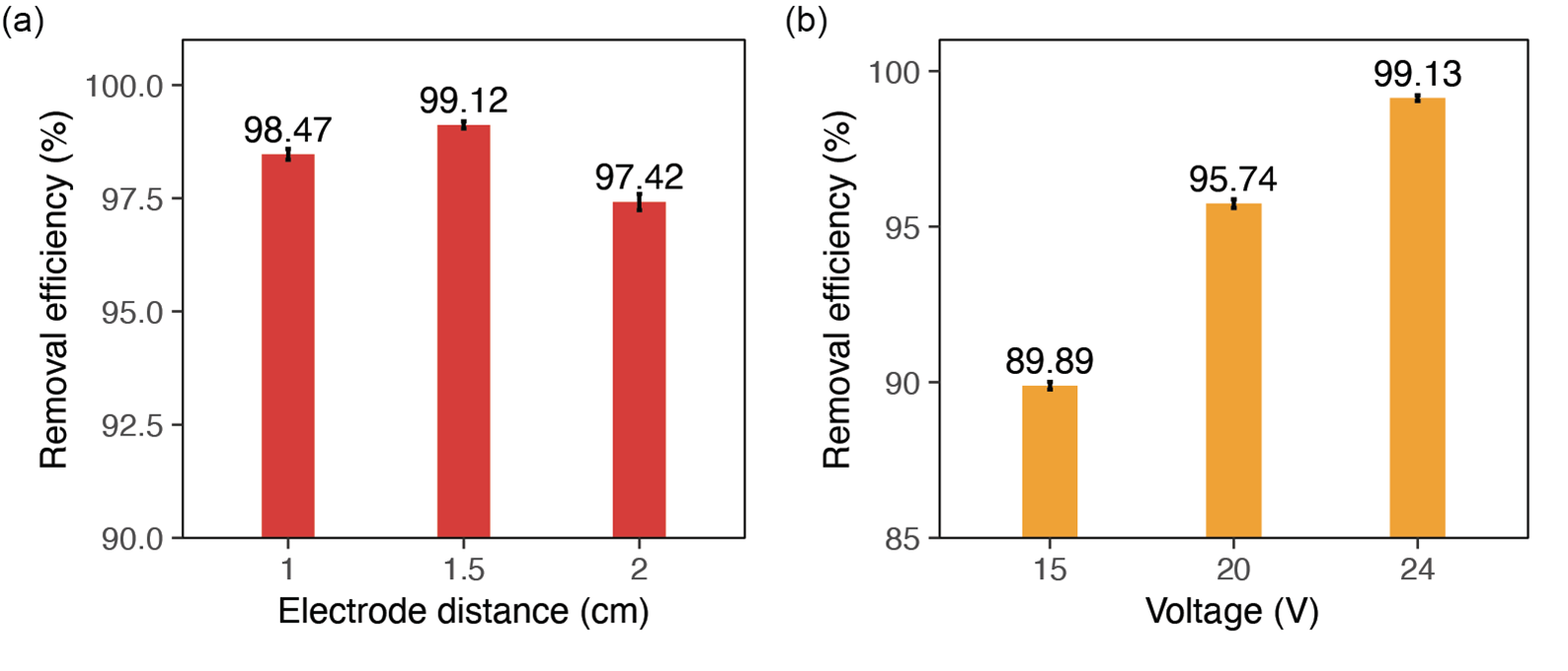Enhanced methylene blue removal from aqueous solution by electrocoagulation technique using combined iron and copper electrode
Main Article Content
Abstract
The rapid advancement in the industrial sector, particularly within the textile industry, necessitates the use of colorants for fabric processing, with methylene blue being a predominant choice. However, the improper disposal of methylene blue dyes can lead to significant environmental hazards, underscoring the need for effective treatment methods before release into ecosystems. This study explores electrocoagulation, an innovative treatment technique powered by electrical energy, as a potential solution for mitigating the environmental impact of methylene blue in textile wastewater. The research investigates the efficiency of the electrocoagulation process using iron (Fe) and copper (Cu) electrodes under various operational conditions, including electrode spacing (1, 1.5, and 2 cm), applied voltage (15, 20, and 24 volts), and electrode contact time (5, 10, 15, 20, 30, and 60 minutes). The findings reveal that the electrocoagulation method achieves an optimal methylene blue removal efficiency of 99% under specific conditions: an electrode distance of 1.5 cm, an applied voltage of 24 volts, and a contact duration of 30 minutes. This research underscores the potential of electrocoagulation as an efficient and environmentally friendly approach for the treatment of textile wastewater, contributing to the sustainable management of industrial effluents.
Article Details
References
[1] S. Garcia-Segura, M. M. S. G. Eiband, J. V. de Melo, C. A. Martínez-Huitle, Electrocoagulation and advanced electrocoagulation processes: A general review about the fundamentals, emerging applications and its association with other technologies, Journal of Electroanalytical Chemistry 801 (2017) 267–299. https://doi.org/10.1016/j.jelechem.2017.07.047.
[2] Z. Derakhshan, M. A. Baghapour, M. Ranjbar, M. Faramarzian, Adsorption of Methylene Blue Dye from Aqueous Solutions by Modified Pumice Stone: Kinetics and Equilibrium Studies, Health Scope 2 (3) (2013) 136–144. https://doi.org/10.17795/jhealthscope-12492.
[3] I. E. Suprihatin, R. M. Suat, I. M. S. Negara, FOTODEGRADASI ZAT WARNA METHYLENE BLUE DENGAN SINAR UV DAN FOTOKATALIS NANOPARTIKEL PERAK, Jurnal Kimia (Journal of Chemistry) (2022) 168–173https://doi.org/10.24843/JCHEM.2022.v16.i02.p06.
[4] G. Qian, L. Li, X. Hu, X. Yu, L. Ye, Enhancement of the biodegradability of activated sludge by the electric-coagulation multistage A/O membrane bioreactor treating low C/N industrial wastewater, International Biodeterioration & Biodegradation 125 (2017) 1–12. https://doi.org/10.1016/j.ibiod.2017.08.004.
[5] H. Al_Aoh, R. Yahya, M. Maah, M. Radzi, M. R. Bin Abas, Adsorption of methylene blue on activated carbon fiber prepared from coconut husk: isotherm, kinetics and thermodynamics studies Adsorption of methylene blue on activated carbon fiber prepared from coconut husk: isotherm, kinetics and thermodynamics studies, Desalination and Water Treatment 52 (2013) 1–13. https://doi.org/10.1080/19443994.2013.831794.
[6] B. C. Melo, F. A. Paulino, V. A. Cardoso, A. G. Pereira, A. R. Fajardo, F. H. Rodrigues, Cellulose nanowhiskers improve the methylene blue adsorption capacity of chitosan-g-poly(acrylic acid) hydrogel, Carbohydrate Polymers 181 (2018) 358–367. https://doi.org/10.1016/j.carbpol.2017.10.079.
[7] M. H. Farzana, S. Meenakshi, Visible light-driven photoactivity of zinc oxide impregnated chitosan beads for the detoxification of textile dyes, Applied Catalysis A: General 503 (2015) 124–134. https://doi.org/10.1016/j.apcata.2014.12.034.
[8] J. Wang, Z. Wu, T. Li, J. Ye, L. Shen, Z. She, F. Liu, Catalytic PVDF membrane for continuous reduction and separation of p-nitrophenol and methylene blue in emulsified oil solution, Chemical Engineering Journal 334 (2018) 579–586. https://doi.org/10.1016/j.cej.2017.10.055.
[9] P. Aravind, H. Selvaraj, S. Ferro, M. Sundaram, An integrated (electro- and bio-oxidation) approach for remediation of industrial wastewater containing azo-dyes: Understanding the degradation mechanism and toxicity assessment, Journal of Hazardous Materials 318 (2016) 203–215. https://doi.org/10.1016/j.jhazmat.2016.07.028.
[10] X. Li, J. Song, J. Guo, Z. Wang, Q. Feng, Landfill leachate treatment using electrocoagulation, Procedia Environmental Sciences 10 (2011) 1159–1164. https://doi.org/10.1016/j.proenv.2011.09.185.
[11] X. Duan, P. Wu, K. Pi, H. Zhang, D. Liu, A. R. Gerson, Application of Modified Electrocoagulation for Efficient Color Removal from Synthetic Methylene Blue Wastewater, International Journal of Electrochemical Science 13 (6) (2018) 5575–5588. https://doi.org/10.20964/2018.06.15.
[12] W. P. Utomo, Z. V. Nugraheni, A. Rosyidah, O. M. Shafwah, L. K. Naashihah, N. Nurfitria, I. F. Ullfindrayani, Penurunan Kadar Surfaktan Anionik dan Fosfat dalam Air Limbah Laundry di Kawasan Keputih, Surabaya menggunakan Karbon Aktif, Akta Kimia Indonesia 3 (1) (2018) 127–140, number: 1. https://doi.org/10.12962/j25493736.v3i1.3528.
[13] T. Trisnaawati, H. Purnama, Pengaruh waktu dan jarak elektroda pada pengolahan lindi dengan metode elektrokoagulasi-adsorpsi zeolit, Jurnal Teknik Kimia 27 (2) (2021) 54–60. https://doi.org/10.36706/jtk.v27i2.714.
[14] P. Prayitno, V. Ridantami, I. Prayogo, REDUKSI AKTIVITAS URANIUM DALAM LIMBAH RADIOAKTIF CAIR MENGGUNAKAN PROSES ELEKTROKOAGULASI, Urania Jurnal Ilmiah Daur Bahan Bakar Nuklir 22 (3) (Jan. 2017). https://doi.org/10.17146/urania.2016.22.3.3187.
[15] A. Hidayanti, U. I. Afifa, Pengaruh Tegangan Elektrokoagulasi dan Konsentrasi Awal Pewarna terhadap Persentase Penyisihan Remazol Red RB, Sarjana, Universitas Brawijaya (May 2019). URL https://repository.ub.ac.id/id/eprint/172780/
[16] N. P. Setianingrum, A. Prasetya, PENGARUH TEGANGAN LISTRIK, JARAK ANTAR ELEKTRODA DAN WAKTU KONTAK TERHADAP PENURUNAN ZAT WARNA REMAZOL RED RB MENGGUNAKAN METODE ELEKTROKOAGULASI, Jurnal Sains dan Teknologi (2017).
[17] R. A. Hamid, P. Purwono, W. Oktiawan, Penggunaan Metode Elektrolisis Menggunakan Elektroda Karbon dengan Variasi Tegangan Listrik dan Waktu Elektrolisis dalam Penurunan Konsentrasi Tss dan Cod pada Pengolahan Air Limbah Domestik, Journal:eArticle, Diponegoro University, issue: 1 Pages: 1-18 Publication Title: Jurnal Teknik Lingkungan Volume: 6 (2017). URL https://www.neliti.com/publications/192565/
[18] I. Andesgur, L. Hakim, T. S. Julianto, PENGOLAHAN LINDI (Leachate) DARI TPA DENGAN PROSES ELEKTROKOAGULASI – SEDIMENTASI DAN FILTRASI, Jurnal Sains dan Teknologi 13 (1), number: 1 (Mar. 2016). https://doi.org/10.31258/jst.v13.n1.pp.
[19] M. S. Mahmoud, J. Y. Farah, T. E. Farrag, Enhanced removal of Methylene Blue by electrocoagulation using iron electrodes, Egyptian Journal of Petroleum 22 (1) (2013) 211–216. https://doi.org/10.1016/j.ejpe.2012.09.013.

